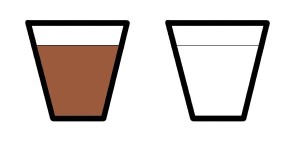Coffee and Cream
I was recently reminded of an excellent math problem involving mixtures.
Imagine yourself sitting in front of a cup of coffee and a cup of cream.
 Suppose you take a spoonful of cream, pour it into the coffee, and stir it up. Now once that’s thoroughly mixed, you take a spoonful of the mixture and pour it back into the cream. Then you mix that up. After all of this, is there more coffee in the cream, more cream in the coffee, or equal amounts in both?
Suppose you take a spoonful of cream, pour it into the coffee, and stir it up. Now once that’s thoroughly mixed, you take a spoonful of the mixture and pour it back into the cream. Then you mix that up. After all of this, is there more coffee in the cream, more cream in the coffee, or equal amounts in both?
I encourage you to think about the problem before perusing the several solutions below!
Related Posts
- Coffee and Cream — A Straightforward Solution
- Coffee and Cream — An Elegant Solution
- Coffee, Cream, and Making a Wish
9 Comments
kIMbER-ly · October 26, 2010 at 12:20 am
Does anyone know the correct answer?
I picked there’s more cream in the coffee…
Hope I am right!!
Jonathan Schwartz · October 31, 2010 at 6:17 am
I remember this problem!
MrHonner · October 31, 2010 at 8:00 am
Ah, but do you remember the solution?
Amrisha · November 12, 2010 at 2:35 pm
I found a similar problem on the quantitative math section of the common admission test (CAT) in India. its a ratio problem, the mixture transfered back takes mostly coffee (since the mixture is mostly coffee) and leaves a large amount of cream. the cream cup get mostly coffee the way it works out, the amount of coffee transfered back is the same as the amount of cream left behind.
the ratios are equal
Prof. W. · January 3, 2012 at 3:07 pm
Imagine you have 2 units of coffee and 2 units of cream. Take 1 unit of cream and mix it into the coffee. So now the coffee cup is 2 units coffee, 1 unit cream. Now take 1 unit from the coffee cup (which is 1/3 units cream and 2/3 units coffee) and return it to the original cup. Do the math. The coffee cup now has 2/3 units cream and 4/3 units coffee. Therefore, the cream cup now has 4/3 units cream and 4/3 units coffee. The ratios are the same. Note that the result will be the same regardless of the original amounts of each liquid.
MrHonner · January 3, 2012 at 5:26 pm
Thanks for the response. Your solution is similar to the “Straightforward” solution below.
https://mrhonner.com/2010/11/02/cofffe-and-cream-a-solution/
Moreover, if instead of assuming there are 2 units of each, a remarkable think happens when you assume there is only 1 unit of each–see the “Make a Wish” solution.
https://mrhonner.com/2010/12/03/coffee-cream-and-making-a-wish/
Lastly, I encourage you check out my colleague’s very elegant solution that doesn’t bother with actual amounts.
https://mrhonner.com/2010/11/09/coffee-and-cream-another-solution/
zeyad etman · June 18, 2016 at 7:46 pm
my answer is more cream in the coffee, in other words more of the first cup i’ll take from it .
my explanation is in the first step the spoonful consisted of pure cream, then the second spoonful from the coffee cup consisted of “cream and coffee” and for each step the spoonful will consist of the mix and impossible it’s contain pure coffee.
in math: coffee -> 5cf , cream -> 5cr
1st step: 5cr-1cr, 5cf+1cr
2nd step: 4cr+.5cf+.5cr=4.5cr+.5cf , 5cf+1cr-.5cf-.5cr=4.5cf+.5cr //equal
3rd step: 4.5cr+.5cf-.5cf-.5cr=4cr , 4.5cf+.5cr+.5cf+.5cr=5cf+1cr //cr is more in coffee cup
MrHonner · June 19, 2016 at 7:15 pm
If I’m following your mathematics correctly, I think your error is in assuming that when the *second* spoonful (the one you put back into the first cup) is half coffee and half cream.
After the spoonful of cream is added to the coffee, the cup is thoroughly mixed. A spoonful of that mixture won’t be comprised of half coffee and half cream.
zeyad etman · June 19, 2016 at 11:05 pm
i’m sorry, let me fix it with general formula:
we will assume that x+n=1; //1 as the size of spoonful.
and will assume that 5 as a cup size.
1st step: 5cr-1cr, 5cf+1cr = 4cr , 5cf + 1cr
2nd step: 4cr+ncf+(x-n)cr=(4+x-n)cr+ncf, 5cf+1cr-ncf-(x-n)cr= (5-n)cf + (1-x+n)cr //General formula
let’s try some cases like n=0.2 , n=0.1 and n=0.6;
*the ratio is the origin content/the other content “important note”
1st cup”cr” (ratio) — 2nd cup”cf” (ratio)
(4.6)cr+.8cf (5.75) — (4.8)cf+(1.6)cr (3) // cr > in coffee
(4.8)cr+.1cf (48) — (4.9)cf+(1.8)cr (2.7) // cr > in coffee
(3.8)cr+.6cf (6.3) — (4.4)cf+(1.2)cr (3.7) // cr > in coffee
let’s try n=.5 :))
4cr+.5cf (8) — 4.5cf+1cr (4.5) //cr > in coffee, okay that’s great!